
Force_on_Force
.pdf
INFANTRY COMBAT
Republican Guard units and the Marines are all at street level, so the second Guard unit blocks the first unit’s fire.
movement rate. All units have two movement rates, Tactical or Rapid. If he doesn’t declare a movement rate, it’s assumed the unit is moving at Tactical speed.
Movement may be restricted or modified by Terrain Effects (see pg. 56 ) or scenario specific conditions.
Tactical Movement
Tactical Movement allows units to take advantage of available cover and carefully assess their surroundings for threats. Units making a Tactical move suffer no Reaction Test modifiers.
Infantry units may make a Tactical move of up to 6”. Mounted units may make a Tactical move of up to 8”. Vehicles may make a Tactical move of up to 10”.
FOG OF WAR
“Fog of War” is a term used to describe the tendency for things to become confused and unmanageable on the battlefield. Fog of War cards simulate this effect by providing an opportunity for unpredictable challenges or opportunities to arise.
In Force on Force, a player draws a Fog of War card if he rolls an unmodified “1” on a Reaction Test. The Fog of War card will indicate whether the player must play the card immediately or may hold it in his hand and play it later.
Fog of War cards may affect either or both players – the card drawn will indicate which force will suffer (or enjoy) its effects.
Some scenarios will dictate that Fog of War cards should be drawn at the start of the game or when certain milestones in the scenario are met – others may dictate that no Fog of War cards are used, even if a “1” is rolled on a Reaction Test.
MOVEMENT
When a player decides to move an activated unit, he must declare what unit he’s moving and at what
Tactical |
Movement |
|
Units that move more than 6” in a turn are using Rapid movement.
Units may make a Rapid move and then fire, but may not fire and then make a Rapid move. It is much easier to dash into position and start firing than it is to disengage at a sprint.
Units that have moved rapidly receive a -1 penalty to all Reaction Test die rolls and lose one die of Firepower for the remainder of the turn.
31

FORCE ON FORCE
Rapid |
Movement |
|
also extremely vulnerable to fire, so units attacking them receive an additional die of Firepower.
Infantry units may make a Rapid move of up to 12”. Mounted units may make a Rapid move of up to 16”. Vehicles may make a Rapid move of up to 20”.
Moving Units on the Table
To simplify movement, Force on Force bases unit movement on the position of a unit’s leader. To move a unit, simply measure movement for the unit’s leader and then place the members of his unit within cohesion distance around him.
Out of Contact Movement
Out of Contact Movement may only be utilized by units designated by a scenario. Generally, units capable of Out of Contact Movement will be local guerrillas, special forces units, or Irregulars under the command of an attached leader.
Out of Contact Movement is generally only allowed to one side in a scenario and may only be used while that side is the non-initiative force.
A unit capable of Out of Contact Movement that is not currently visible to any initiative unit, i.e., no
initiative unit has an open Line of Sight to it, may move anywhere on the table as long as it can trace a path from its current position to the spot it wishes to move to without crossing any initiative unit’s line of sight. Note that UAVs belonging to the initiative force will prevent Out of Contact Movement altogether.
Units utilizing Out of Contact Movement must end their movement before they enter an initiative unit’s line of sight.
This unrestricted movement is meant to represent the uncertainty of local force dispositions until the initiative force is able to fix their actual positions by moving into contact or through aerial reconnaissance.
FIRE COMBAT
The following sections describe infantry fire combat in Force on Force. These rules approach combat with an emphasis on Troop Quality and the ability of units to react fluidly to one another’s actions. Some aspects of the rules, such as group cover and LOS, may be different than what you’re used to, but be patient and you’ll soon see how everything fits together to provide a quicker, more realistic feeling game.
Rounds of Fire
When a unit reacts to fire from another unit by firing back, it is referred to as a Round of Fire. Make a reaction Test to determine which unit fires first in a Round of Fire.
When one unit engages another with fire, either as an Action or Reaction, a Reaction test is made to see which unit fires first. The unit that passes the test with the highest die score will fire first. In the case of a tie (or if neither side passes the test with a 4+), the initiative unit will fire first.
The side that fires first will resolve its fire as described in Resolving Fire Combat, below. If the unit receiving fire first survives, it will return fire unless it has suffered some morale effect that prevents it from doing so, has
32
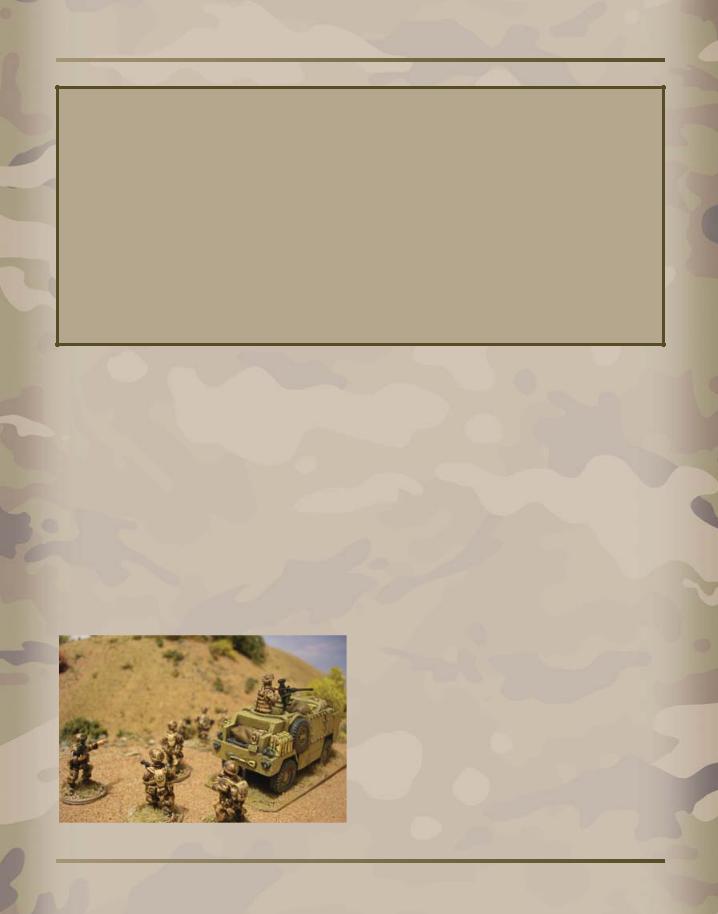
INFANTRY COMBAT
Designers’ Note: Where’s the Weapon List?
Force on Force puts less emphasis on the specific weapons used in a firefight than on the skill and training of the combatants using them. Rather than focus minutely on the individual characteristics of weapons, comparing one weapon’s range, reliability and accuracy to another’s, we assume that all classes of weapons designed to perform the same battlefield tasks are basically analogous – it is the man using the tool that makes the difference.
Low Troop Quality units may be using “better”
weapons than a higher Troop Quality unit, but it’s doubtful that the differences in weapon performance will make up for the disparity in training and experience. On the other hand, high Troop Quality units are familiar with their weapons and know how to take advantage of their strengths and compensate for their weaknesses.
This philosophy is represented in game terms by Force on Force’s use of Troop Quality as the key factor in determining the effectiveness of unit’s fire.
been completely wiped out, or has no remaining Firepower dice.
When both units have fired, the round of fire is complete.
Note that irregular units may only participate in a round of fire that they have initiated by action or reaction. Otherwise, they must receive fire without responding to it. Since an irregular unit can only be activated or react once per turn, they can only engage in one Round of Fire per turn.
Resolving Fire Combat
To resolve Fire Combat, both units involved determine how many dice they have in Firepower and Defense. Each unit rolls the appropriate number of Troop Quality dice and discards any dice with a score lower than the target number (4+). The defender matches his Defense dice to the attacker’s Firepower dice, attempting to equal or exceed the score on each dice. Any die which the unit being fired on cannot equal or exceed causes a casualty.
|
Defense |
British soldiers on patrol in Helmand |
Defense represents a unit’s ability to protect itself from |
Province, Afghanistan (Britannia Miniatures) |
enemy fire, either by wise selection of cover, use of body |
|
|
|
armor, or through effective counter-fire. Better trained |
|
|
|
or more experienced units are more likely to get the |
|
most out of the defensive options available to them, so |
|
Defense is tied directly to Troop Quality. |
|
A unit’s Defense is equal to the sum of their Basic |
|
Defense plus Cover and Armor dice. |
|
Basic Defense |
|
A unit’s basic Defense is equal to the number of figures |
|
in the unit or the number of Firepower dice with which |
|
33

FORCE ON FORCE
it is being attacked, whichever is less. Extra Defense dice for armor or cover are then added to the basic Defense to determine the unit’s final defense value. The type of die thrown is determined by the unit’s Troop Quality.
A unit’s Defense can never be reduced to zero. No matter what negative factors apply, a unit will always have at least one Defense die.
Basic Defense
Basic Defense = Number of Figures in Unit or the Firepower of the attack against it, whichever is less.
Effective Defense
A unit’s Defense is equal to the sum of their Basic Defense plus Cover and Armor dice.
Example: A group of 8 militia soldiers is being fired on by a fireteam with a Firepower of 5D. The militiamen are moving on the other side of a brick wall and can claim Solid Cover. Since the militiamen are being attacked with a Firepower of 5D, their basic defense is 5D rather than 8D. They can claim Solid Cover, though, which bumps their defense to 6D. The militiamen have a D6 Troop Quality, so their final Defense total in this situation would be 6D6.
Cover Dice
Although Force on Force is played on a tabletop, the battles the games represent are not! Even the flattest expanse of land is crisscrossed with wrinkles and dotted with low rises which might provide ample cover for a unit of infantry. It must therefore be assumed that our gaming tables contain similar features which might provide cover for our figures.
To represent this “invisible terrain”, we assume that any unit that is not Exposed (see below) is taking advantage of unseen terrain features.
In instances where terrain features exist to provide obvious cover, its benefit is not determined on a per figure basis, but rather on the position of the unit as a whole. If half or more of a given unit is behind cover, the entire unit receives the benefit of that cover.
Cover modifiers that overlap are cumulative.
Example: Six Jesh A’l Mahdi militiamen move into position in the cover of some low walls surrounding a fountain. 4 of the JAM militiamen make it behind the walls, but two are left in the open. Since half or more of the militia figures are in Solid Cover, the entire unit is considered to be in Solid Cover.
More than Half of the Irregulars Below
Are In Solid Cover
Units may receive additional dice to their Defense based on any additional cover beyond the usual battlefield clutter:
In Cover (+1 Defense Die): A unit that does not move may declare that it is “In Cover.” Units may get “In Cover” anywhere, even in a position that would normally be Exposed. Being “In Cover” represents a unit using all available cover to its full advantage, even if that means little more than laying a little flatter on the ground. In Cover units benefit if they’re using better cover, so the In Cover bonus is applied in addition to any
34
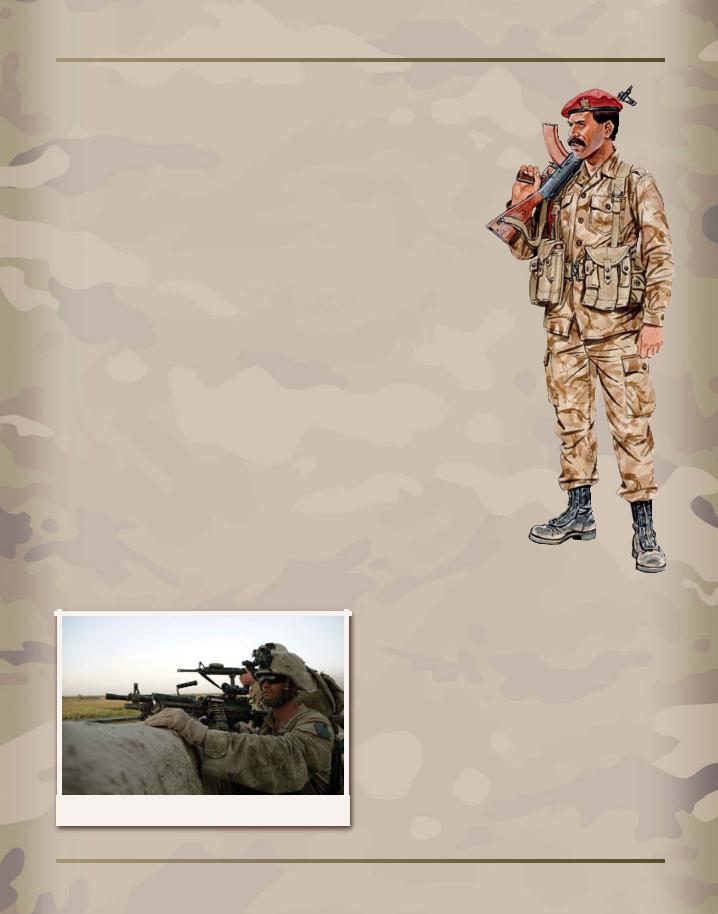
INFANTRY COMBAT
other cover bonuses the unit might receive for being behind Solid Cover, in a Fortified Position, etc.
Regular units are automatically In Cover on any activation that they do not move and are not Exposed.
Irregulars that have not moved during their activation and Exposed Regular units must pass a Quality Check to get “In Cover.”
Pinned units may take a Quality Check to get In Cover even if they have moved. This bonus die is cumulative with other applicable Defense Dice.
Solid Cover (+1 Defense Die): Cover that has a good chance of deflecting or outright stopping bullets is considered to be Solid Cover. Some examples of Solid Cover might include concrete or adobe buildings, sand bags, stone walls, wrecked APCs, etc. A unit isn’t required to be In Cover to benefit from Solid Cover.
Intervening Cover: If enemy fire passes over an intervening terrain feature, such as a stone wall, an AFV, etc. to reach a unit, that unit may claim the Solid Cover bonus.
Improved Cover (+2 DefenseDice): Cover that has been reinforced for extra protection against enemy fire
– such as trenches, sandbagged walls, etc.
Fortified Cover (+3 Defense Dice): Fortifications designed specifically to provide protection from gunfire
A unit behind Solid Cover
Mechanized Infantryman,
Iraqi Republican Guard,
Kuwait, 1991
and blast effects, such prepared trenches, log bunkers, small concrete pill-boxes, etc. Such positions
are generally available unless a specifically states they present.
Fortified Position Defense Dice): sheltering within positions fortified protect them from are particularly difficult out. Units in bunkers,
buildings, or improved networks receive the Position bonus. positions are generally available unless a
specifically states they are present.
Exposed (+1 Firepower Die for Attacker): If a unit is in open ground and is not within 2” of a scenic piece representing cover of some sort, it is considered to be Exposed. Exposed units are extremely vulnerable to fire, so units attacking them receive an extra Firepower Die.
Armor Dice
Units who are wearing body armor receive additional Defense dice.
Light Body Armor (+1 Defense Die)
Heavy or Improved Body Armor (+2 Defense Dice)
Units wearing armor are designated by the scenario.
35
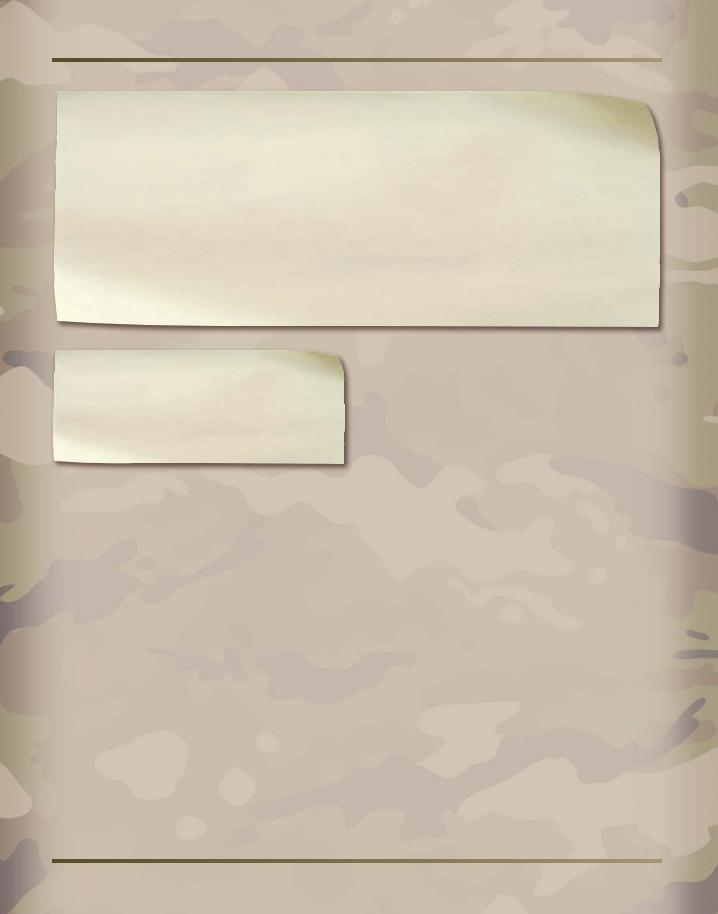
FORCE ON FORCE
Cover Dice
In Cover: +1D
Solid Cover (inside buildings, behind walls, etc.): +1D
Deployed Smoke this Turn: +1D
Improved Cover (shallow trenches, sandbagged walls, etc.): +2D
Intervening Cover: If enemy fire passes over an intervening terrain feature to reach a unit, it may claim the Solid Cover bonus (assuming the terrain would provide Solid Cover under
Body Armor Dice
Light Body Armor: +1 Defense Die Heavy/Improved Body Armor: +2 Defense Dice
Firepower
A unit’s Firepower represents its capability to bring effective fire against the enemy. Force on Force works on the assumption that the quality of the man using the weapon is more important than minor differences between individual weapons within the same class. As a result, a unit’s Troop Quality is the most important factor in determining its Firepower.
To determine a unit’s Firepower, total the number of figures in the unit. Subtract any dice lost from Reactions or Overwatch fire. The resulting total is the attacking unit’s basic Firepower.
Add any Support Weapon or bonus dice to the basic Firepower dice to determine the unit’s final, adjusted Firepower. This is the number of Troop Quality dice the unit will throw in an attack.
normal circumstances).
Fortified Cover (purpose built trenches, log bunkers, and other field fortifications): +3D
Reinforced Fortification (concrete bunkers with firing slits): +4D
Exposed: +1 Firepower Die for Attacker
All modifiers are cumulative.
A unit’s Defense can never be reduced to zero.
No matter what negative factors apply, a unit will always have at least one Defense die.
Optimum Range
The ranges for most weapons exceed the size of most tables used for Force on Force games. Units who are within Optimum Range of a target, however, have a better chance of causing casualties. Troops with better training or more experience have a greater Optimum Range than less experienced opponents.
Optimum Range should not be confused with “effective range,” which is a term with a very specific meaning: It is the distance at which a weapon may be expected to fire accurately enough to inflict damage or casualties. The effective range for most weapons used in the game will be many times the width of even the largest tables.
Our term, Optimum Range, refers to the distance on the tabletop at which the average soldier of a given Troop Quality is likely to cause a wounding hit. It is a measure of the firer’s ability to shoot well, rather than a gauge of the weapon’s innate accuracy.
Optimum Range is directly linked to a firing unit’s Troop Quality: The higher the unit’s Troop Quality, the greater its Optimum Range.
There is no “maximum range” for most weapons. If a target is in LOS, it is generally considered to be “in range.” Exceptions are noted in the rules.
36
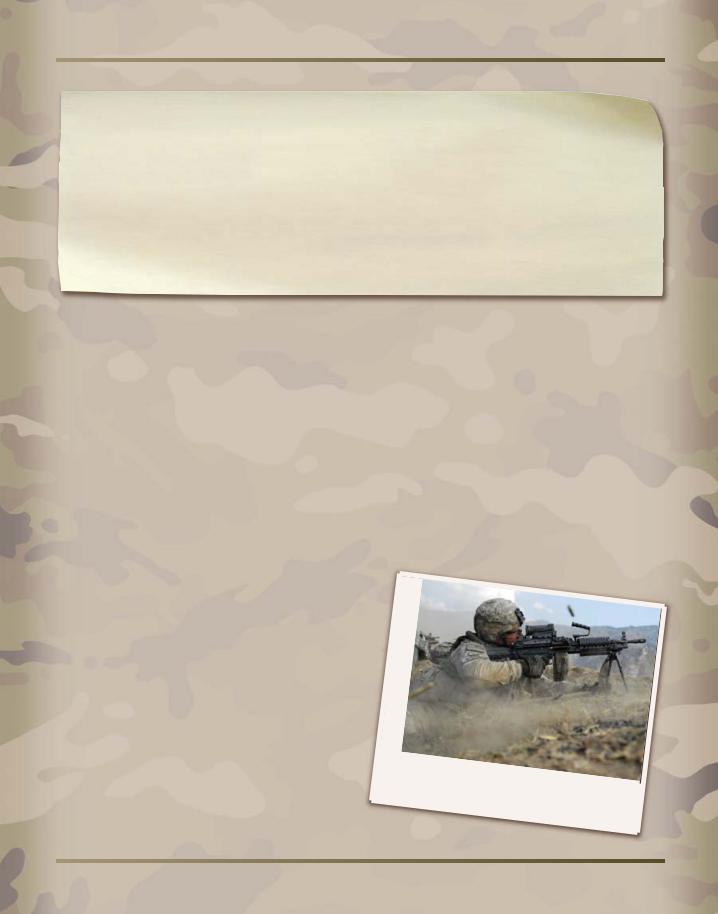
INFANTRY COMBAT
Optimum Range and Troop Quality
D12 Troop Quality Units have an Optimum Range of 12”
D10 Troop Quality Units have an Optimum Range of 10”
D8 Troop Quality Units have an Optimum Range of 8”
D6 Troop Quality Units have an Optimum Range of 6”
A unit only receives one Optimum Range die per round of fire.
A unit can only claim an Optimum Range die if all the weapons used in the attack are within Optimum Range.
Example 1: A Trained fireteam of four soldiers, two armed with rifles and one each with a grenade launcher and a SAW, are firing at an enemy unit 7” away. Since the enemy unit is within Optimum Range of all the fireteam’s weapons (8” for the rifles, 16” for the grenade launcher and SAW), the fireteam receives a bonus Firepower die.
Example 2: The same fireteam described above is firing at an enemy unit that is 14” away. If the entire unit fires at the distant enemy, the Fireteam does not receive the
Optimum Range bonus (14” is beyond the rifles’ Optimum Range). If the fireteam decides to split their fire, firing the
SAW and grenade launcher at the enemy unit 14” away, that portion of their fire would receive the Optimum
Range bonus die.
Support Weapons and units with enhanced optics have twice the usual Optimum Range for their Troop Quality.
Vehicle mounted and emplaced Support Weapons always treat their attacks as being within Optimum Range, regardless of the distance fired.
There is no “maximum range” for most weapons. Exceptions are noted in the rules.
such weapons include SAWs, GPMGs, and grenade launchers, RPGs, heavy machineguns, etc.
Figures using Support Weapons add dice to their unit’s Firepower in excess of the dice received for the figures themselves.
Support Weapons fall into the following general categories:
Light Support (+1 Firepower Die): Light Support Weapons are man-portable and can be operated without assistance – although an assistant gunner may be on hand to spot or pass ammunition, his services are not required to operate the weapon
Support Weapon Dice
Infantry Support Weapons are more powerful than ordinary small arms. They are generally used against other infantry, but some infantry support weapons also have anti-armor capabilities. In Force on Force,
US |
|
|
|
|
|
soldier |
|
|
|
|
|
Weapon |
firing a |
Squad |
|
|
|
(SAW) which |
Automatic |
|
|||
Support |
is |
|
|
||
Weapon] |
classified |
|
|||
|
|
|
|
as a |
|
|
|
|
|
|
Light |
37
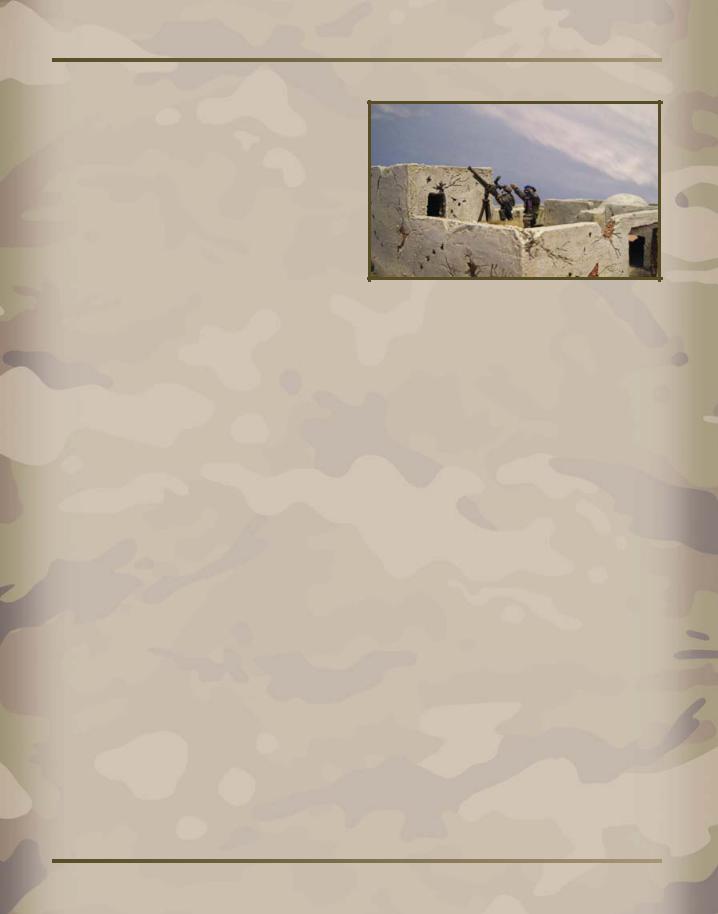
FORCE ON FORCE
effectively. Light Support Weapons generally use standard small arms ammunition, but have a greater range or rate of fire than their smaller brethren.
Examples of Light Support Weapons include: SAWs, Rifle Grenade Launchers, Grenade Launchers, and Very Light Mortars
Medium Support (+2 Firepower Die): Medium Support Weapons usually require a crew of at least two for transport and effective operation. They are often vehicle mounted or emplaced. Other Medium Support Weapons, such as RPGs and other shoulder launched missiles, are easily portable but cause increased damage due to their explosive power. Medium Support Weapons that make a Rapid Move receive no Support Weapon dice at all.
Medium Support Weapons tend to be a bit unwieldy due to their weight and size. As a result, any unit that moves in a turn receives one bonus Firepower die rather than two (i.e., an RPG team with a normal Firepower of 5D would have a Firepower of 4D during any turn in which it moved).
Examples of Medium Support Weapons include: GPMGs, AGLs, standard RPGs
Heavy Support (+3 Firepower Die): Heavy Support Weapons are rarely man-portable and are usually vehicle mounted or emplaced. However, some of the more powerful man-portable missile systems are also classified as Heavy Support Weapons due to their devastating explosive power.
Heavy Support weapons are generally large, weighty chunks of ordnance, making moving and firing them in a short period of time difficult. As a result, any Heavy Weapon that make a Tactical Move during a turn suffers a two dice penalty to its Firepower (i.e., a HMG team that normally had a Firepower of 8D would be reduced to a Firepower of 6D if it moved during a turn). Heavy support Weapons whose crew makes a Rapid Move may not fire at all.
Taliban fighters man a Soviet AA gun
(Britannia Miniatures)
Heavy Support Weapons include: HMGs, AT missiles, AT RPG
Example: A unit of Taliban consisting of six men, four armed with an AK, one with an RPD and one with an RPG moves around the corner of a compound and fires at an American Ranger fireteam. The Taliban unit has a basic firepower of 6 (one die for each figure in the unit). One of the figures is armed with an RPD, a Light Support Weapon that adds a bonus die, raising the Firepower to 7. Another one is armed with an RPG, which would normally provide two bonus dice to the Firepower of the unit. Since the unit moved this turn the RPG suffers a one die penalty, so it only provides one bonus die. This results in the unit of Taliban having a Firepower of 6 + 1 + (2-1) = 8.
Support Weapon Annotation
The “stats” for a support weapon are abbreviated in unit organization or vehicle write-ups. The “stat-line” for a support weapon indicates the weapon’s class, and the number of anti-personnel (AP) Firepower dice it adds to a unit (or throws, in the case of a vehicle). If the weapon has anti-tank capabilities, it’s AT factor is listed along with its AT gun class.
38
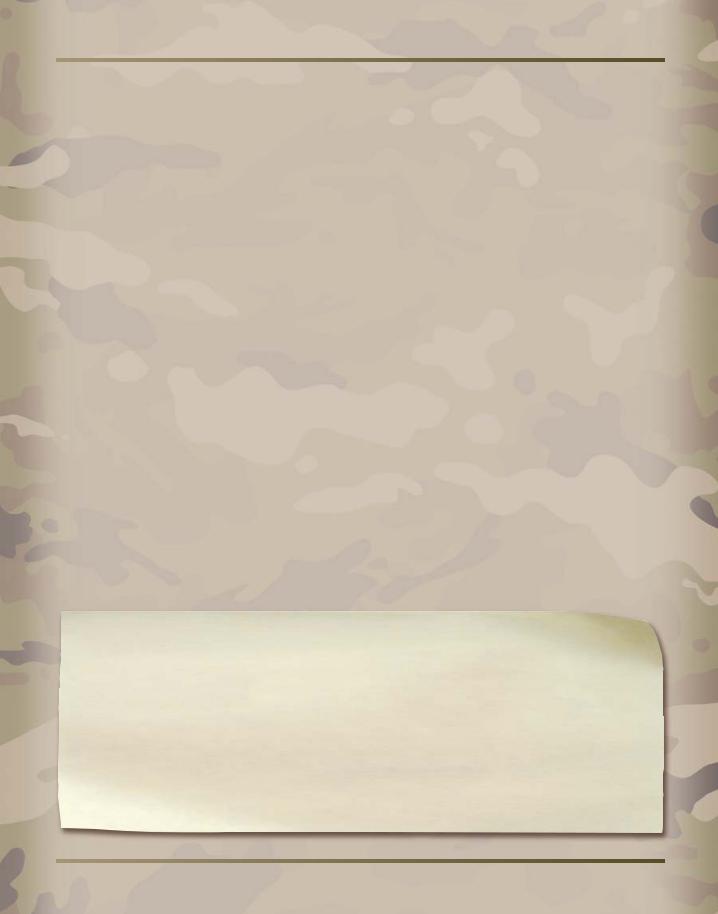
INFANTRY COMBAT
As an example, a light support weapon, such as a SAW, would have a stat-line like this: Lt. AP:1 (Light support, +1 die to anti-personnel Firepower).
An anti-tank RPG would look like this: Hvy. AP:3/AT:2(M) (Heavy support, +3 dice to antipersonnel Firepower, AT factor of 2, classed as a Medium (M) gun).
Diminishing Firepower
The more frantic a unit’s movement and fire becomes, the less effective it is. To represent this, a unit’s Firepower diminishes the more it does in a single turn.
The first time a unit fires per turn, it uses its full Firepower. After that, a unit loses one die of Firepower:
Each time it fires as part of an Activation, Reaction, or Overwatch.
Each time it moves as part of an Activation, Reaction or Morale test failure.
When a unit’s Firepower is reduced to zero, it may no longer fire during that turn.
The Firepower Cap
No infantry unit may have a total Firepower greater than 10 dice.
This rule reflects the fact that there are limits to even the most highly trained unit’s fire discipline.
Note that all negative penalties are applied to the 10D cap, regardless of the number of figures in the unit.
Vehicular weapons, bombs, and certain game effects are exempt from the 10D cap.
Example: A mob of 12 Taliban, some armed with RPK machineguns and RPGs are firing at a unit of British SAS sheltering in a boulder strewn ravine. The Taliban fighters’ total Firepower is nearly 20D, but it is reduced to 10D due to the Firepower Cap. The Taliban have Poor Supplies, earning them -1 die penalty to their Firepower, reducing it to 9D for this attack.
Splitting Fire
Units normally find that it is tactically advantageous to group their fire, but there may be situations in which a unit would benefit from splitting its fire between multiple targets in the same activation.
Note that a unit that fires on infantry with its small arms while using Support Weapons to engage a vehicle is not considered to be splitting its fire.
To split fire, the owning player must announce what targets a unit is going to engage and how many Firepower Dice will be devoted to each target. Support
Firepower
Number of Figures + Special Weapon Dice = Number of Troop Quality Dice in Firepower
+1 die if in Optimum Range
+1 die if target Unit is Exposed
+1 if unit is Well Supplied
-1 die if unit made a Rapid Move this turn
-1 die for each Reaction/Overwatch fire after the first in a turn
-1 die for each move as part of a Reaction or Morale test failure
-1 die in defensive fire vs. Close Assault -1 die if unit is Poorly Supplied
Infantry Firepower may never exceed 10D. All negative penalties are applied to the 10D cap, regardless of the number of figures in the unit
39
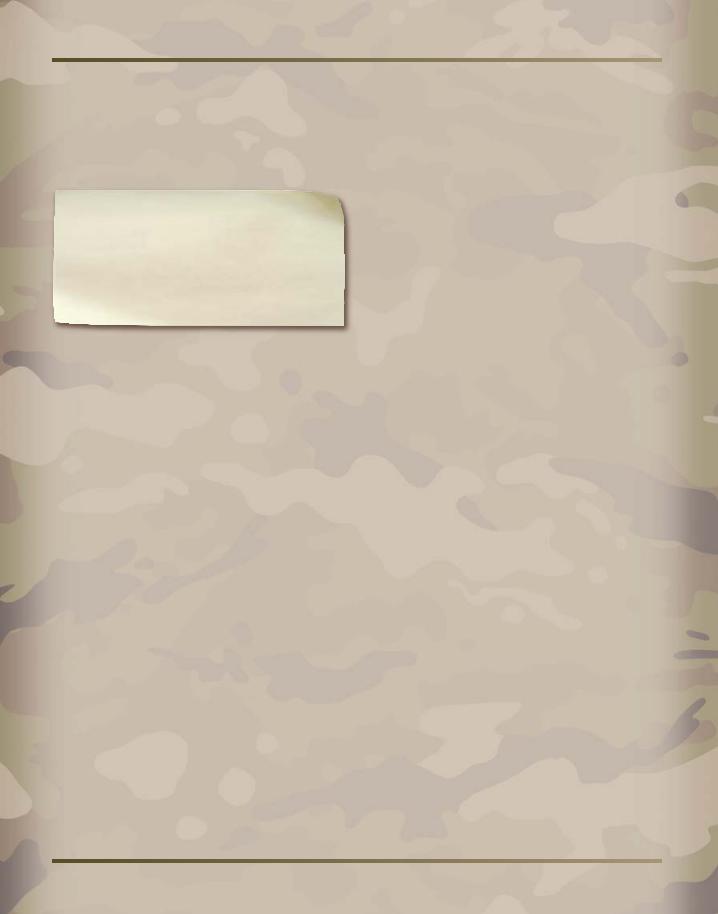
FORCE ON FORCE
Weapon dice must be allocated to one target and may not be split among multiple targets.
The number of targets a unit can service is limited by its Troop Quality.
Targets Engaged by Quality
D6 Troop Quality: May only engage ONE target
D8 Troop Quality: May engage TWO targets
D10 Troop Quality: May engage THREE targets
D12 Troop Quality: May engage FOUR targets
Example: A Russian unit taking cover in a traffic circle is being engaged from two sides by Georgians. The Russians are D8 Troop Quality, so they can split their fire between two targets. They have a Firepower of 6 (4 figures plus 2 dice for two Light Support weapons – a SAW and RGL). The player decides to split his fire exactly in half, with one rifleman and the SAW gunner engaging one group of Georgians and the other rifleman and RGL engaging the other. The Russians will engage each unit with a Firepower of 3.
Making the Attack Roll
To determine the outcome of an attack during a firefight, the attacker rolls his adjusted Firepower versus the defending unit’s adjusted Defense.
The attacker rolls a number of dice equal to his adjusted Firepower and discards any dice with a score of less than 4.
The defender rolls a number of dice equal to his adjusted Defense and discards any dice with a score of less than 4.
The defender matches his Defense dice to the attacker’s Firepower dice, attempting to match each of the attacker’s dice with an equal or higher die roll.
The defender may arrange his successful dice against the attacker’s successful dice as he sees fit.
Any of the attacker’s dice with a score of 4 or greater that cannot be equaled or exceeded by a Defense Die indicates a casualty.
Example: A fireteam of 5 D10 Troop Quality Marines (3 with rifles, one with a SAW, and one with a Rifle GL) make a ranged fire attack on a unit of 4 Taliban crouched behind a low mud wall. The Taliban are within the Marines’ Optimum Range.
The Marine player’s Firepower is 7 (one for each figure in the fireteam), +1 die each for the SAW and Rifle GL, which are Light Support Weapons). The Taliban are in Optimum Range for all the unit’s weapons, so it receives another bonus die. The Marines’ final Firepower total is 8D10.
The Taliban’s basic Defense is 4 dice, one for each member of the unit, which is less than the Marines’ 8D Firepower. Since a unit’s basic Defense is equal to the lesser of the number of figures in the unit or the Firepower of the attack directed against it, the Taliban have an unmodified Defense of 4D. Any Cover dice are added to this, so the Taliban receive +1 Defense die for being In Cover and another +1 die for the Solid Cover provided by the wall. This brings their Defense total to 6D8 (these Taliban have a Troop Quality of D8).
The Marine player rolls his Firepower of 8D10, noting each individual roll: 10, 9, 7, 5, 4 (he also rolled a 3 and two 1s, but since those are not a 4 or higher, they are discarded).
The Taliban player rolls 6D8 for Defense and notes the result of each die: 8, 5, 4, 4, 3, and 2. The rolls of 3 and 2 are discarded.
The dice are laid out and the Taliban player matches his Defense dice against the Marines’ Firepower dice as best he can, trying to equal or exceed as many of the attacker’s scores as possible.
40
